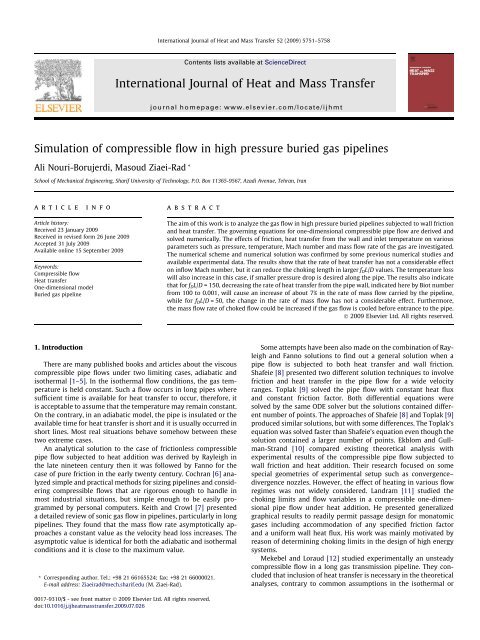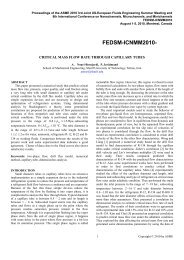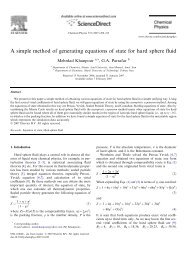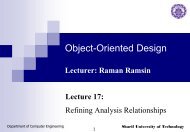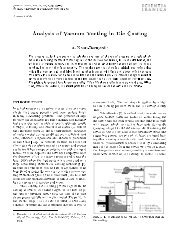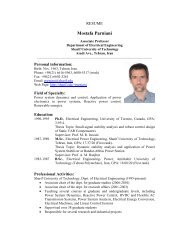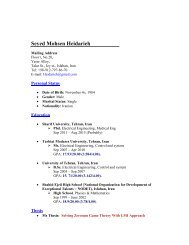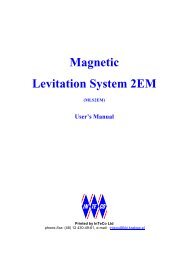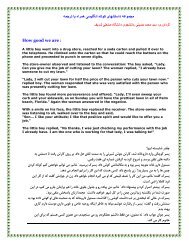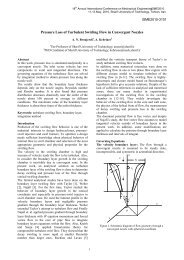Simulation of compressible flow in high pressure buried gas pipelines
Simulation of compressible flow in high pressure buried gas pipelines
Simulation of compressible flow in high pressure buried gas pipelines
Create successful ePaper yourself
Turn your PDF publications into a flip-book with our unique Google optimized e-Paper software.
International Journal <strong>of</strong> Heat and Mass Transfer 52 (2009) 5751–5758<br />
Contents lists available at ScienceDirect<br />
International Journal <strong>of</strong> Heat and Mass Transfer<br />
journal homepage: www.elsevier.com/locate/ijhmt<br />
<strong>Simulation</strong> <strong>of</strong> <strong>compressible</strong> <strong>flow</strong> <strong>in</strong> <strong>high</strong> <strong>pressure</strong> <strong>buried</strong> <strong>gas</strong> pipel<strong>in</strong>es<br />
Ali Nouri-Borujerdi, Masoud Ziaei-Rad *<br />
School <strong>of</strong> Mechanical Eng<strong>in</strong>eer<strong>in</strong>g, Sharif University <strong>of</strong> Technology, P.O. Box 11365-9567, Azadi Avenue, Tehran, Iran<br />
article<br />
<strong>in</strong>fo<br />
abstract<br />
Article history:<br />
Received 23 January 2009<br />
Received <strong>in</strong> revised form 26 June 2009<br />
Accepted 31 July 2009<br />
Available onl<strong>in</strong>e 15 September 2009<br />
Keywords:<br />
Compressible <strong>flow</strong><br />
Heat transfer<br />
One-dimensional model<br />
Buried <strong>gas</strong> pipel<strong>in</strong>e<br />
The aim <strong>of</strong> this work is to analyze the <strong>gas</strong> <strong>flow</strong> <strong>in</strong> <strong>high</strong> <strong>pressure</strong> <strong>buried</strong> pipel<strong>in</strong>es subjected to wall friction<br />
and heat transfer. The govern<strong>in</strong>g equations for one-dimensional <strong>compressible</strong> pipe <strong>flow</strong> are derived and<br />
solved numerically. The effects <strong>of</strong> friction, heat transfer from the wall and <strong>in</strong>let temperature on various<br />
parameters such as <strong>pressure</strong>, temperature, Mach number and mass <strong>flow</strong> rate <strong>of</strong> the <strong>gas</strong> are <strong>in</strong>vestigated.<br />
The numerical scheme and numerical solution was confirmed by some previous numerical studies and<br />
available experimental data. The results show that the rate <strong>of</strong> heat transfer has not a considerable effect<br />
on <strong>in</strong><strong>flow</strong> Mach number, but it can reduce the chok<strong>in</strong>g length <strong>in</strong> larger f D L/D values. The temperature loss<br />
will also <strong>in</strong>crease <strong>in</strong> this case, if smaller <strong>pressure</strong> drop is desired along the pipe. The results also <strong>in</strong>dicate<br />
that for f D L/D = 150, decreas<strong>in</strong>g the rate <strong>of</strong> heat transfer from the pipe wall, <strong>in</strong>dicated here by Biot number<br />
from 100 to 0.001, will cause an <strong>in</strong>crease <strong>of</strong> about 7% <strong>in</strong> the rate <strong>of</strong> mass <strong>flow</strong> carried by the pipel<strong>in</strong>e,<br />
while for f D L/D = 50, the change <strong>in</strong> the rate <strong>of</strong> mass <strong>flow</strong> has not a considerable effect. Furthermore,<br />
the mass <strong>flow</strong> rate <strong>of</strong> choked <strong>flow</strong> could be <strong>in</strong>creased if the <strong>gas</strong> <strong>flow</strong> is cooled before entrance to the pipe.<br />
Ó 2009 Elsevier Ltd. All rights reserved.<br />
1. Introduction<br />
There are many published books and articles about the viscous<br />
<strong>compressible</strong> pipe <strong>flow</strong>s under two limit<strong>in</strong>g cases, adiabatic and<br />
isothermal [1–5]. In the isothermal <strong>flow</strong> conditions, the <strong>gas</strong> temperature<br />
is held constant. Such a <strong>flow</strong> occurs <strong>in</strong> long pipes where<br />
sufficient time is available for heat transfer to occur, therefore, it<br />
is acceptable to assume that the temperature may rema<strong>in</strong> constant.<br />
On the contrary, <strong>in</strong> an adiabatic model, the pipe is <strong>in</strong>sulated or the<br />
available time for heat transfer is short and it is usually occurred <strong>in</strong><br />
short l<strong>in</strong>es. Most real situations behave somehow between these<br />
two extreme cases.<br />
An analytical solution to the case <strong>of</strong> frictionless <strong>compressible</strong><br />
pipe <strong>flow</strong> subjected to heat addition was derived by Rayleigh <strong>in</strong><br />
the late n<strong>in</strong>eteen century then it was followed by Fanno for the<br />
case <strong>of</strong> pure friction <strong>in</strong> the early twenty century. Cochran [6] analyzed<br />
simple and practical methods for siz<strong>in</strong>g pipel<strong>in</strong>es and consider<strong>in</strong>g<br />
<strong>compressible</strong> <strong>flow</strong>s that are rigorous enough to handle <strong>in</strong><br />
most <strong>in</strong>dustrial situations, but simple enough to be easily programmed<br />
by personal computers. Keith and Crowl [7] presented<br />
a detailed review <strong>of</strong> sonic <strong>gas</strong> <strong>flow</strong> <strong>in</strong> pipel<strong>in</strong>es, particularly <strong>in</strong> long<br />
pipel<strong>in</strong>es. They found that the mass <strong>flow</strong> rate asymptotically approaches<br />
a constant value as the velocity head loss <strong>in</strong>creases. The<br />
asymptotic value is identical for both the adiabatic and isothermal<br />
conditions and it is close to the maximum value.<br />
* Correspond<strong>in</strong>g author. Tel.: +98 21 66165524; fax: +98 21 66000021.<br />
E-mail address: Ziaeirad@mech.sharif.edu (M. Ziaei-Rad).<br />
Some attempts have been also made on the comb<strong>in</strong>ation <strong>of</strong> Rayleigh<br />
and Fanno solutions to f<strong>in</strong>d out a general solution when a<br />
pipe <strong>flow</strong> is subjected to both heat transfer and wall friction.<br />
Shafeie [8] presented two different solution techniques to <strong>in</strong>volve<br />
friction and heat transfer <strong>in</strong> the pipe <strong>flow</strong> for a wide velocity<br />
ranges. Toplak [9] solved the pipe <strong>flow</strong> with constant heat flux<br />
and constant friction factor. Both differential equations were<br />
solved by the same ODE solver but the solutions conta<strong>in</strong>ed different<br />
number <strong>of</strong> po<strong>in</strong>ts. The approaches <strong>of</strong> Shafeie [8] and Toplak [9]<br />
produced similar solutions, but with some differences. The Toplak’s<br />
equation was solved faster than Shafeie’s equation even though the<br />
solution conta<strong>in</strong>ed a larger number <strong>of</strong> po<strong>in</strong>ts. Ekblom and Gullman-Strand<br />
[10] compared exist<strong>in</strong>g theoretical analysis with<br />
experimental results <strong>of</strong> the <strong>compressible</strong> pipe <strong>flow</strong> subjected to<br />
wall friction and heat addition. Their research focused on some<br />
special geometries <strong>of</strong> experimental setup such as convergence–<br />
divergence nozzles. However, the effect <strong>of</strong> heat<strong>in</strong>g <strong>in</strong> various <strong>flow</strong><br />
regimes was not widely considered. Landram [11] studied the<br />
chok<strong>in</strong>g limits and <strong>flow</strong> variables <strong>in</strong> a <strong>compressible</strong> one-dimensional<br />
pipe <strong>flow</strong> under heat addition. He presented generalized<br />
graphical results to readily permit passage design for monatomic<br />
<strong>gas</strong>es <strong>in</strong>clud<strong>in</strong>g accommodation <strong>of</strong> any specified friction factor<br />
and a uniform wall heat flux. His work was ma<strong>in</strong>ly motivated by<br />
reason <strong>of</strong> determ<strong>in</strong><strong>in</strong>g chok<strong>in</strong>g limits <strong>in</strong> the design <strong>of</strong> <strong>high</strong> energy<br />
systems.<br />
Mekebel and Loraud [12] studied experimentally an unsteady<br />
<strong>compressible</strong> <strong>flow</strong> <strong>in</strong> a long <strong>gas</strong> transmission pipel<strong>in</strong>e. They concluded<br />
that <strong>in</strong>clusion <strong>of</strong> heat transfer is necessary <strong>in</strong> the theoretical<br />
analyses, contrary to common assumptions <strong>in</strong> the isothermal or<br />
0017-9310/$ - see front matter Ó 2009 Elsevier Ltd. All rights reserved.<br />
doi:10.1016/j.ijheatmasstransfer.2009.07.026
5752 A. Nouri-Borujerdi, M. Ziaei-Rad / International Journal <strong>of</strong> Heat and Mass Transfer 52 (2009) 5751–5758<br />
Nomenclature<br />
Bi Biot number, h 1 (D/2 + d)/k S<br />
C P specific heat capacity<br />
D pipe <strong>in</strong>side diameter<br />
f friction factor<br />
G mass velocity, qV<br />
g function<br />
H depth <strong>of</strong> <strong>buried</strong> pipe center<br />
h heat transfer coefficient, enthalpy, spatial step<br />
k thermal conductivity, Runge–Kutta coefficients<br />
L pipe length pffiffiffiffiffiffiffiffi<br />
M Mach number, V= cRT<br />
m number <strong>of</strong> discretization po<strong>in</strong>ts<br />
_m mass <strong>flow</strong> rate, pD 2 qV/4<br />
n Haaland equation coefficient<br />
Pr Prandtl number, m/a<br />
p static <strong>pressure</strong><br />
_q 00 heat flux<br />
R <strong>gas</strong> constant<br />
Re Reynolds number, qVD/l<br />
S Sutherland constant temperature<br />
St Stanton number, U/GC P<br />
T static temperature<br />
U overall heat transfer coefficient<br />
V velocity<br />
x spatial position<br />
Greek letters<br />
a thermal diffusivity<br />
b cluster<strong>in</strong>g parameter<br />
c specific heat ratio<br />
D difference<br />
d wall thickness<br />
e roughness<br />
g panel efficiency<br />
l dynamic viscosity<br />
q density<br />
Subscripts<br />
1, 2 <strong>in</strong>let, outlet<br />
0 stagnation<br />
D Darcy<br />
g <strong>gas</strong><br />
i <strong>in</strong>side<br />
j node <strong>in</strong>dex<br />
s soil<br />
w pipe wall<br />
wa adiabatic wall<br />
1 ambient<br />
Superscripts<br />
dimensionless<br />
chok<strong>in</strong>g condition<br />
adiabatic <strong>flow</strong>s. The Experimental results <strong>of</strong> external <strong>flow</strong>s [13]<br />
show that heat<strong>in</strong>g <strong>gas</strong> <strong>flow</strong> can reduce the sk<strong>in</strong> friction and even<br />
a very significant reduction will be achieved if the surface near<br />
the lead<strong>in</strong>g edge is heated. In a numerical and experimental work<br />
by Garcia et al. [14], the <strong>in</strong>ternal <strong>compressible</strong> <strong>flow</strong> was studied at<br />
T-type junctions without consider<strong>in</strong>g the heat transfer effects. In<br />
another experimental and numerical <strong>in</strong>vestigation <strong>of</strong> <strong>compressible</strong><br />
subsonic <strong>flow</strong>s <strong>in</strong> long micro conduits by Harley et al. [15], it was<br />
suggested that the locally fully developed approximation could<br />
be used to <strong>in</strong>terpret the experimental data for low and moderate<br />
Mach numbers.<br />
In all <strong>of</strong> the previous works, no research has been conducted on<br />
wall heat transfer from a <strong>buried</strong> pipe with convection on the exposed<br />
ground surface or <strong>in</strong><strong>flow</strong> temperature effect on both <strong>pressure</strong><br />
loss and mass <strong>flow</strong> rate <strong>of</strong> <strong>gas</strong> <strong>flow</strong> which is important <strong>in</strong><br />
<strong>gas</strong> transmission efficiency. Therefore, the objective <strong>of</strong> this work<br />
is to exam<strong>in</strong>e numerically the effect <strong>of</strong> heat transfer and wall friction<br />
on turbulent subsonic pipe <strong>flow</strong> to obta<strong>in</strong> a maximum efficiency<br />
<strong>of</strong> the <strong>gas</strong> transmission pipel<strong>in</strong>es.<br />
2. Govern<strong>in</strong>g equations<br />
Fig. 1 shows a schematic <strong>of</strong> <strong>buried</strong> <strong>gas</strong> transmission pipel<strong>in</strong>e between<br />
two <strong>gas</strong> stations and the related geometrical parameters<br />
used <strong>in</strong> this study. The conservation <strong>of</strong> mass, momentum and the<br />
equation <strong>of</strong> state for <strong>compressible</strong> one-dimensional steady-state<br />
<strong>gas</strong> <strong>flow</strong> through a circular pipe are as follows:<br />
G ¼ qV ¼ constant<br />
@<br />
@x ðqV 2 Þ¼<br />
@p f D<br />
@x 2D qV 2<br />
P ¼ qRT<br />
The Darcy friction factor is mostly presented by well-known<br />
Colebrook equation, but the implicit character <strong>of</strong> this correlation<br />
ð1Þ<br />
ð2Þ<br />
ð3Þ<br />
has created a need for a simpler explicit correlation. Many such correlations<br />
have been presented and one is the Haaland equation [16].<br />
1<br />
p ffiffiffiffi ¼ 1:8 <br />
n<br />
f D<br />
n log 6:9<br />
e 1:11n<br />
<br />
þ<br />
ð4Þ<br />
Re 3:75D<br />
Haaland [16] claimed that this equation is especially suited for <strong>gas</strong><br />
pipel<strong>in</strong>es if n = 3, giv<strong>in</strong>g a more abrupt transition between smooth<br />
and rough <strong>flow</strong>. This explicit friction factor relation is based on<br />
the Colebrook equation and the accuracy is expected to be very similar.<br />
In this relation, e is the pipe roughness and Re = qVD/l is<br />
Reynolds number. The <strong>gas</strong> viscosity temperature dependent by<br />
Sutherland law is:<br />
3=2 <br />
T T<br />
l ¼ l<br />
1 þ S<br />
1<br />
ð5Þ<br />
T þ S<br />
T 1<br />
where l 1 is measured at the <strong>in</strong><strong>flow</strong> temperature T 1 and S is the<br />
Sutherland constant.<br />
Introduc<strong>in</strong>g<br />
p<br />
Eqs. (1), (3) and the Mach number <strong>of</strong> a perfect <strong>gas</strong><br />
as V ¼ M cRT<br />
ffiffiffiffiffiffiffiffi<br />
<strong>in</strong>to Eq. (2), the govern<strong>in</strong>g Eqs. (1)–(3) can be reformed<br />
<strong>in</strong> two new differential equations as<br />
2<br />
3<br />
dp<br />
¼<br />
cp<br />
4 5 ð6Þ<br />
d f Dx<br />
D<br />
dM 2<br />
M 2<br />
¼ dT<br />
T<br />
1<br />
1 þ cM 2 2 M2 þ dM2<br />
2 dp<br />
p<br />
d f Dx<br />
D<br />
When the <strong>gas</strong> is brought to rest at the wall so even if there is no<br />
heat transfer at the wall, the wall temperature will be <strong>high</strong>er than<br />
the <strong>gas</strong> temperature. The heat transfer can only be from the wall<br />
to the <strong>gas</strong> if T 1 > T Wa . From this discussion, it follows that the most<br />
appropriate temperature to take as the <strong>gas</strong> temperature is T Wa .In<br />
this case, the energy equation <strong>of</strong> the <strong>gas</strong> <strong>flow</strong> with overall heat<br />
transfer coefficient between the ambient and the <strong>gas</strong> adiabatic temperature<br />
is:<br />
ð7Þ
A. Nouri-Borujerdi, M. Ziaei-Rad / International Journal <strong>of</strong> Heat and Mass Transfer 52 (2009) 5751–5758 5753<br />
Gas station 1 Gas station 2<br />
A<br />
h,T<br />
∞<br />
∞<br />
k S<br />
x<br />
L<br />
A<br />
H<br />
δ<br />
Section A-A<br />
Fig. 1. A schematic <strong>of</strong> <strong>buried</strong> <strong>gas</strong> pipel<strong>in</strong>e between two pump<strong>in</strong>g <strong>gas</strong> stations.<br />
D<br />
<br />
pDUðT 1 T wa Þdx ¼ _md h þ 1 <br />
2 V 2<br />
ð8Þ<br />
h i D<br />
k g<br />
¼ 0:023Re 0:8 Pr 1 3<br />
ð14Þ<br />
where the adiabatic wall temperature based on the static and stagnation<br />
<strong>gas</strong> temperatures is:<br />
T wa T<br />
T 0 T ¼ Pr1 3<br />
ð9Þ<br />
. with T 0 ¼ T 1 þ c 1<br />
2 M2 Us<strong>in</strong>g _m ¼ pD 2 G=4, h = C T and V ¼ M p ffiffiffiffiffiffiffiffi<br />
cRT<br />
p<br />
<strong>in</strong>to Eq. (8), the f<strong>in</strong>al result will be:<br />
" #<br />
dT<br />
dð f D x=DÞ ¼ 1 4St<br />
c 1<br />
1 þ c ðT 1<br />
1 T wa Þ<br />
2 M2 f D 2 T dM 2<br />
ð10Þ<br />
dð f D x=DÞ<br />
where St = U/GC P is termed the Stanton number and is def<strong>in</strong>ed<br />
based on the ambient and adiabatic wall temperatures difference.<br />
This equation represents the <strong>gas</strong> temperature along the pipe <strong>in</strong> differential<br />
form. Insert<strong>in</strong>g Eqs. (6) and (10) <strong>in</strong>to Eq. (7), the follow<strong>in</strong>g<br />
result can be obta<strong>in</strong>ed for Mach number along the pipe.<br />
dM 2<br />
<br />
dðf D x=DÞ ¼<br />
M2<br />
1 M 4St ð1 þcM 2 Þ T <br />
1 T wa<br />
þcM 2 1 þ c 1 <br />
2 f D T<br />
2 M2<br />
ð11Þ<br />
The overall heat transfer coefficient appears <strong>in</strong> the def<strong>in</strong>ition <strong>of</strong> the<br />
Stanton number consider<strong>in</strong>g the convection on the exposed ground<br />
surface is expressed as:<br />
1<br />
U ¼ 1 D lnð1 þ 2d=DÞ Dcosh 1<br />
þ þ<br />
h i 2k w<br />
2gk s<br />
<br />
2H<br />
Dþ2d<br />
<br />
ð12Þ<br />
where d and H are the wall thickness and depth <strong>of</strong> the <strong>buried</strong> pipe<br />
center to the ground surface. Parameters k w and k S are the thermal<br />
conductivity <strong>of</strong> the pipe and soil, respectively. The panel efficiency,<br />
g, is used to take <strong>in</strong>to account the effects <strong>of</strong> f<strong>in</strong>ite convection heat<br />
loss from the exposed ground surface. It is a strong function <strong>of</strong> both<br />
the Biot number and H/D and asymptotically approach to unity as<br />
the Biot number becomes large regardless <strong>of</strong> the value <strong>of</strong> H/D. For<br />
H/D = 1.5 it can be correlated by the numerical values <strong>of</strong> Chung<br />
et al. [17] as:<br />
g ¼ 0:8882Bi 0:2379 ; if 0:001 < Bi 0:5<br />
g ¼ 0:9025Bi 0:0276 ; if 0:5 < Bi 100<br />
ð13Þ<br />
where Bi = h 1 (D/2+d)/k s .<br />
The <strong>in</strong>side heat transfer coefficient based on Dittus–Boelter<br />
equation for fully developed pipe <strong>flow</strong> is as follows:<br />
where k g is the thermal conductivity <strong>of</strong> the <strong>gas</strong>. By simultaneous<br />
solution <strong>of</strong> Eqs. (10) and (11) numerically for temperature and<br />
Mach number and us<strong>in</strong>g Eq. (6) for the calculation <strong>of</strong> the <strong>pressure</strong>,<br />
all <strong>of</strong> the <strong>flow</strong> parameters can be determ<strong>in</strong>ed. When the out<strong>flow</strong><br />
Mach number reaches one, the <strong>flow</strong> will be choked and the value<br />
<strong>of</strong> the mass <strong>flow</strong> rate approaches to a maximum.<br />
3. Numerical procedure<br />
The set <strong>of</strong> ord<strong>in</strong>ary differential equations (10) and (11) can be<br />
re-written as:<br />
dM<br />
dx ¼ g 1 ðx ; M; T Þ<br />
dT<br />
dx ¼ g 2 ðx ; M; T Þ<br />
with the follow<strong>in</strong>g <strong>in</strong>itial conditions:<br />
ð15Þ<br />
Mðx 1 ¼ 0Þ ¼M 1; T ðx 1<br />
¼ 0Þ ¼1 ð16Þ<br />
<strong>in</strong> which g 1 and g 2 are dimensionless functions. All <strong>of</strong> the parameters<br />
have been made dimensionless accord<strong>in</strong>g to the follow<strong>in</strong>g<br />
parameters:<br />
x ¼ f D x=D; p ¼ p=p 1 ;<br />
_m ¼ _m= _m 1 ; T ¼ T=T 1 ; V ¼ V=V 1<br />
ð17Þ<br />
where subscript ‘1’ denotes values at the <strong>in</strong><strong>flow</strong>. _m 1 is the mass <strong>flow</strong><br />
rate computed at T = T 1 .<br />
S<strong>in</strong>ce the govern<strong>in</strong>g equations are <strong>high</strong>ly non-l<strong>in</strong>ear and the<br />
<strong>flow</strong> variables change very rapidly at the out<strong>flow</strong> where the choked<br />
condition occurs, it is necessary to pack the computational nodes<br />
near the out<strong>flow</strong> such that there are enough nodes around the<br />
choked po<strong>in</strong>t. Hence, for the location <strong>of</strong> the grid nodes <strong>in</strong> <strong>flow</strong><br />
direction, the follow<strong>in</strong>g algebraic relation is used to locate the nodal<br />
po<strong>in</strong>ts.<br />
2<br />
3<br />
n 1<br />
x ¼ f bþ1<br />
DL 6<br />
1<br />
D 41<br />
þðb þ 1Þ b 1<br />
n<br />
þ 1<br />
bþ1<br />
b 1<br />
7<br />
5 ð18Þ<br />
where b = 1.006 and 0 6 n
T jþ1 ¼ T j<br />
þ 1 6 ðk 1;T þ 2k 2;T þ 2k 3;T þ k 4;T Þ ; j ¼ 1; 2; ...; m 1 ð19Þ<br />
5754 A. Nouri-Borujerdi, M. Ziaei-Rad / International Journal <strong>of</strong> Heat and Mass Transfer 52 (2009) 5751–5758<br />
M jþ1 ¼ M j þ 1 6 ðk 1;M þ 2k 2;M þ 2k 3;M þ k 4;M Þ<br />
The Runge–Kutta method coefficients <strong>in</strong> this equation for each j <strong>in</strong>dex<br />
are also def<strong>in</strong>ed by:<br />
k 1;M ¼ h j g 1 ðx j ; M j; T j<br />
<br />
Þ<br />
k 2;M ¼ h j g 1 x v j<br />
þ h j<br />
2 ; M j þ k <br />
1;M<br />
2 ; T j<br />
<br />
k 3;M ¼ h j g 1 x j<br />
þ h j<br />
2 ; M j þ k <br />
2;M<br />
2 ; T j<br />
k 4;M ¼ h j g 1 ðx j<br />
þ h j ; M j þ k 3;M ; T j Þ<br />
ð20Þ<br />
and<br />
k 1;T<br />
¼ h j g 2 ðx j ; M j; T j<br />
<br />
Þ<br />
k 2;T<br />
¼ h j g 2 x j<br />
þ h j<br />
2 ; M j; T j<br />
þ k <br />
1;T <br />
2<br />
<br />
k 3;T<br />
¼ h j g 2 x j<br />
þ h j<br />
2 ; M j; T j<br />
þ k <br />
2;T <br />
2<br />
k 4;T<br />
¼ h j g 2 ðx j<br />
þ h j ; M j ; T j<br />
þ k 3;T<br />
Þ<br />
ð21Þ<br />
Fig. 2. Effect <strong>of</strong> wall conditions on <strong>gas</strong> <strong>pressure</strong> along the pipe.<br />
where<br />
h j ¼ x jþ1<br />
x j<br />
; j ¼ 1; 2; ...; m 1 ð22Þ<br />
A Fortran code was developed to apply the method for solv<strong>in</strong>g the<br />
derived govern<strong>in</strong>g equations. The code computes the Mach number<br />
and temperature at each nodal po<strong>in</strong>t towards the out<strong>flow</strong>. In each<br />
step, the other <strong>flow</strong> variables such as velocity, <strong>pressure</strong> and density<br />
are determ<strong>in</strong>ed by comb<strong>in</strong><strong>in</strong>g Eqs. (1) and (3), as:<br />
qffiffiffiffiffiffiffiffi<br />
V jþ1 ¼ M jþ1<br />
M 1<br />
T jþ1;<br />
q <br />
p jþ1 ¼ q jþ1 T jþ1 ; jþ1 ¼ 1<br />
V jþ1<br />
; j ¼ 1; 2; ...m 1 ð23Þ<br />
In order to obta<strong>in</strong> the effects <strong>of</strong> heat transfer on the <strong>gas</strong> <strong>flow</strong> under<br />
the choked condition, the solution is started with a very small<br />
<strong>in</strong>itial value for <strong>in</strong>let Mach number, M 1 , then the <strong>flow</strong> variables<br />
such as outlet Mach number, M 2 , be<strong>in</strong>g calculated along the pipe<br />
towards the outlet. In the second step, an <strong>in</strong>crement <strong>of</strong> DM 1 is<br />
added to M 1 , and M 2 is calculated aga<strong>in</strong> at the outlet. This procedure<br />
is repeated until the outlet Mach number reaches one<br />
(M 2 = 1). The value <strong>of</strong> DM 1 <strong>in</strong> each step should be selected very<br />
carefully, because the out<strong>flow</strong> Mach number is very sensitive to<br />
DM 1 for long pipes. This can cause a major error <strong>in</strong> the computational<br />
calculations. The change <strong>of</strong> the outlet Mach number (DM 2 )<br />
between two steps is calculated and controlled by the change <strong>of</strong><br />
DM 1 <strong>in</strong> an automatic way. The value <strong>of</strong> DM 1 is selected <strong>in</strong> the range<br />
<strong>of</strong> 10 10 < DM 1
A. Nouri-Borujerdi, M. Ziaei-Rad / International Journal <strong>of</strong> Heat and Mass Transfer 52 (2009) 5751–5758 5755<br />
correspond<strong>in</strong>g to M 2 = 1 at the out<strong>flow</strong>. The dimensionless wall<br />
heat flux has been def<strong>in</strong>ed by q ¼ 4M 1<br />
_q 00 =ðf D hGÞ 1<br />
<strong>in</strong> which h, M<br />
and G are the <strong>gas</strong> enthalpy, Mach number and mass <strong>flow</strong> rate per<br />
unit area all at the <strong>in</strong>let conditions respectively. The plot also <strong>in</strong>cludes<br />
the results <strong>of</strong> Landram [11]. It can be seen that heat<strong>in</strong>g<br />
the <strong>gas</strong> <strong>flow</strong> can reduce the chok<strong>in</strong>g length. This means that the<br />
pipe <strong>flow</strong> with heat<strong>in</strong>g needs a shorter length than that without<br />
heat<strong>in</strong>g.<br />
5. Results and discussion<br />
The capacity <strong>of</strong> a transmission network depends on static and<br />
dynamic elements, as well as on operational conditions. The static<br />
elements are the technical characteristics <strong>of</strong> the network itself.<br />
These elements <strong>in</strong>clude the network architecture and the specific<br />
properties <strong>of</strong> the equipments. In a <strong>gas</strong> transmission network, these<br />
properties <strong>in</strong>clude: the diameter <strong>of</strong> the pipel<strong>in</strong>es, the roughness <strong>of</strong><br />
the pipel<strong>in</strong>e material or the friction factor, which has an <strong>in</strong>fluence<br />
on the <strong>pressure</strong> losses and the technical characteristics <strong>of</strong> other<br />
equipments, such as valves or heat<strong>in</strong>g facilities.<br />
The dynamic elements refer to the way the network is be<strong>in</strong>g utilized<br />
and operated. For a <strong>gas</strong> transmission network, these variables<br />
are: the properties <strong>of</strong> the <strong>gas</strong> <strong>in</strong>jected/delivered at the entry/exit<br />
po<strong>in</strong>ts such as <strong>pressure</strong>, temperature and <strong>gas</strong>es chemical composition,<br />
the distribution <strong>of</strong> the nom<strong>in</strong>ations between the various entry<br />
po<strong>in</strong>ts <strong>of</strong> the network and the <strong>gas</strong> demand or mass <strong>flow</strong> rate at the<br />
exit po<strong>in</strong>t.<br />
The operational constra<strong>in</strong>ts are the boundaries set on each variable<br />
by the different parties. In particular: the m<strong>in</strong>imum/maximum<br />
<strong>pressure</strong> guaranteed at the <strong>in</strong>terconnection po<strong>in</strong>ts, the <strong>gas</strong><br />
supply (at the entry po<strong>in</strong>ts) and <strong>of</strong>f-take (at the exit po<strong>in</strong>ts) are required<br />
to be the same with<strong>in</strong> certa<strong>in</strong> marg<strong>in</strong>s, a m<strong>in</strong>imum <strong>gas</strong> <strong>pressure</strong><br />
is required at each exit po<strong>in</strong>t and the operat<strong>in</strong>g limits <strong>of</strong> the<br />
ancillary equipments have to be respected, typically on the volume<br />
<strong>flow</strong> and thermodynamic properties.<br />
By obta<strong>in</strong><strong>in</strong>g the behavior <strong>of</strong> <strong>flow</strong> variables under the heat<br />
transfer and friction factor effects for different static elements, it<br />
is possible to design an economical pipel<strong>in</strong>e for transferr<strong>in</strong>g specific<br />
amount <strong>of</strong> material between two po<strong>in</strong>ts accord<strong>in</strong>g to the effects<br />
<strong>of</strong> these parameters on <strong>flow</strong> losses. The effects <strong>of</strong> heat<br />
transfer is considered by different Biot numbers, while the effects<br />
<strong>of</strong> pipe diameter, pipe length and the friction factor all are summarized<br />
<strong>in</strong> a dimensionless parameter f D L/D. It is notable that for a<br />
specific pipe length between two pump<strong>in</strong>g stations, <strong>in</strong>creas<strong>in</strong>g this<br />
parameter is regarded as <strong>in</strong>creas<strong>in</strong>g the pipe wall roughness or<br />
reduc<strong>in</strong>g the pipe diameter.<br />
With respect to all these parameters, the design <strong>of</strong> the transmission<br />
pipel<strong>in</strong>e would be possible by simultaneously solution <strong>of</strong> presented<br />
differential equations (10) and (11) numerically and<br />
obta<strong>in</strong><strong>in</strong>g all other <strong>flow</strong> parameters such as <strong>pressure</strong>, temperature<br />
and Mach number distributions, as well as the rate <strong>of</strong> mass <strong>flow</strong><br />
carried under different conditions.<br />
Before present<strong>in</strong>g the results, it is noteworthy to mentioned<br />
that the physical properties <strong>of</strong> the common soil are taken as<br />
1 10 7 < a s < 2.4 10 7 m 2 /s and k s = 0.52 W/m K. Also the physical<br />
properties <strong>of</strong> methane as a natural <strong>gas</strong> consist <strong>of</strong> k g = 0.035 W/<br />
mK,Pr = 0.71, molecular weight <strong>of</strong> 16.04 kg/kmol and the specific<br />
heat ratio <strong>of</strong> c = 1.299. The wall thickness and roughness <strong>of</strong> the<br />
steel pipe are assumed to be d = 0.02 m and e = 4.6 10–5 m with<br />
thermal conductivity <strong>of</strong> k w = 30 W/m K. It is also assumed that the<br />
pipel<strong>in</strong>e has a diameter <strong>of</strong> D = 1.4 m and is <strong>buried</strong> under the ground<br />
at a depth <strong>of</strong> H/D = 1.5. The <strong>pressure</strong> and temperature <strong>of</strong> the surround<strong>in</strong>g<br />
air are assumed to be P 1 = 1.01 10 5 Pa and T 1 = 283 K<br />
respectively. The reference mass <strong>flow</strong> rate pass<strong>in</strong>g through the pipe<br />
at T 1 = 303 K and p 1 /p 2 = 2 is equal to _m 1 ¼ 272:85 kg=s. The<br />
choked mass <strong>flow</strong> rate is also def<strong>in</strong>ed at the ambient temperature,<br />
and is equal to _m ¼ 2415:75 kg=s. In this case, the <strong>pressure</strong> ratio<br />
will be p 1 /p 2 = 8.9.<br />
Fig. 4 illustrates the effect <strong>of</strong> heat transfer on the <strong>in</strong>let Mach<br />
number aga<strong>in</strong>st the <strong>pressure</strong> ratio for different values <strong>of</strong> f D L/D. At<br />
a specific value <strong>of</strong> f D L/D, the <strong>in</strong>let Mach number reaches its maximum<br />
value and after that rema<strong>in</strong>s constant. This means that after<br />
this po<strong>in</strong>t the <strong>in</strong><strong>flow</strong> Mach number would be <strong>in</strong>dependent <strong>of</strong> the<br />
<strong>pressure</strong> ratio <strong>in</strong> a choked <strong>flow</strong>. The results, also, show that a bigger<br />
Fig. 4. Effect <strong>of</strong> heat transfer on <strong>in</strong><strong>flow</strong> Mach number for different <strong>pressure</strong> ratios and various f D L/D.
5756 A. Nouri-Borujerdi, M. Ziaei-Rad / International Journal <strong>of</strong> Heat and Mass Transfer 52 (2009) 5751–5758<br />
Fig. 5. Effect <strong>of</strong> heat transfer on out<strong>flow</strong> Mach number for different <strong>pressure</strong> ratios<br />
and various f D L/D.<br />
Fig. 6. Effect <strong>of</strong> heat transfer on temperature loss for different <strong>pressure</strong> ratios and<br />
various f D L/D.<br />
<strong>in</strong><strong>flow</strong> Mach number needs a shorter pipe length to reach a maximum<br />
value or <strong>in</strong> fact a choked <strong>flow</strong> needs a shorter pipe length for<br />
a <strong>high</strong>er <strong>in</strong><strong>flow</strong> Mach number.<br />
The heat transfer effect was also studied here by chang<strong>in</strong>g the<br />
Biot number. Generally speak<strong>in</strong>g, because <strong>of</strong> very low heat addition<br />
to the <strong>gas</strong> <strong>flow</strong> per unit mass, the change <strong>in</strong> Mach number is very<br />
small for all f D L/D. The results were obta<strong>in</strong>ed for a wide range <strong>of</strong><br />
Biot number (0.001 < Bi < 100) and it can be seen that there is no<br />
considerable effect <strong>of</strong> heat transfer regardless <strong>of</strong> wide variation<br />
<strong>in</strong> the <strong>in</strong><strong>flow</strong> Mach number.<br />
Fig. 5 shows the out<strong>flow</strong> Mach number versus the <strong>pressure</strong> ratio<br />
for different f D L/D and Biot numbers. This figure exhibits that a<br />
longer pipel<strong>in</strong>e requires more <strong>in</strong><strong>flow</strong> <strong>pressure</strong> to have a choked<br />
<strong>flow</strong> condition. In addition, comparison between Figs. 4 and 5 <strong>in</strong>dicates<br />
that the change <strong>of</strong> the out<strong>flow</strong> Mach number is more sensitive<br />
to the <strong>in</strong><strong>flow</strong> <strong>pressure</strong> than the <strong>in</strong><strong>flow</strong> Mach number. The<br />
effect <strong>of</strong> heat transfer on out<strong>flow</strong> Mach number can only be observed<br />
for large f D L/D values and large <strong>pressure</strong> ratios, i.e. near<br />
the choked condition. In a specific <strong>pressure</strong> ratio, it was found that<br />
<strong>in</strong>creas<strong>in</strong>g Biot number could <strong>in</strong>crease the out<strong>flow</strong> Mach number<br />
and consequently reduce the chok<strong>in</strong>g length.<br />
Fig. 6 <strong>in</strong>dicates the effect <strong>of</strong> Biot number on the <strong>gas</strong> temperature<br />
loss along the pipel<strong>in</strong>e. Although, there is a small distance between<br />
these l<strong>in</strong>es, it can be <strong>in</strong>vestigated that for large f D L/D values, the<br />
Fig. 7. Effect <strong>of</strong> heat transfer on mass <strong>flow</strong> rate for different <strong>pressure</strong> ratios and various f D L/D.
A. Nouri-Borujerdi, M. Ziaei-Rad / International Journal <strong>of</strong> Heat and Mass Transfer 52 (2009) 5751–5758 5757<br />
Fig. 8. Effect <strong>of</strong> heat transfer and <strong>in</strong><strong>flow</strong> <strong>gas</strong> temperature on the mass <strong>flow</strong> rate for choked <strong>flow</strong>.<br />
out<strong>flow</strong> <strong>gas</strong> temperature drops more than the other cases, especially<br />
for larger Biot numbers. The temperature drop is also more<br />
obvious for lower <strong>pressure</strong> ratios. It means that for large f D L/D values,<br />
the temperature loss will <strong>in</strong>crease, if lower <strong>pressure</strong> drop is<br />
desired along the pipe.<br />
The mass <strong>flow</strong> rates <strong>of</strong> the <strong>gas</strong> <strong>in</strong> the pipe for different f D L/D,<br />
<strong>pressure</strong> ratios and Biot numbers were presented <strong>in</strong> Fig. 7. The reference<br />
mass <strong>flow</strong> rate <strong>in</strong> the denom<strong>in</strong>ator <strong>of</strong> the ord<strong>in</strong>ate axis is<br />
obta<strong>in</strong>ed at the <strong>in</strong>let temperature and the <strong>pressure</strong> ratio <strong>of</strong> p 1 /<br />
p 2 = 2. From this figure, one can observe that though the rate <strong>of</strong><br />
mass carried by the pipel<strong>in</strong>e will be <strong>in</strong>creased by f D L/D, the heat<br />
transfer has more effect on the reduction <strong>of</strong> mass <strong>flow</strong> rate <strong>in</strong> large<br />
f D L/D values. In other words, <strong>in</strong> order to <strong>in</strong>crease the rate <strong>of</strong> mass<br />
<strong>flow</strong> rate from the pipel<strong>in</strong>e with <strong>high</strong>er f D L/D values, one should reduce<br />
the rate <strong>of</strong> heat transfer from the pipel<strong>in</strong>e, while for small f D L/<br />
D values, the heat transfer has no considerable effect on the mass<br />
<strong>flow</strong> rate.<br />
Fig. 8 reports the effect <strong>of</strong> <strong>in</strong><strong>flow</strong> <strong>gas</strong> temperature on the<br />
mass <strong>flow</strong> rate for choked <strong>flow</strong>. The graph was plotted for different<br />
Biot numbers. It is clear that the mass <strong>flow</strong> rate can be <strong>in</strong>creased<br />
if the <strong>in</strong><strong>flow</strong> <strong>gas</strong> temperature is cooled before enter<strong>in</strong>g<br />
to the pipe. However, it is also <strong>in</strong>terest<strong>in</strong>g to note that the<br />
curves correspond<strong>in</strong>g to <strong>high</strong>er Biot numbers change faster than<br />
the l<strong>in</strong>es with lower ones. This means that <strong>in</strong>creas<strong>in</strong>g the Biot<br />
number together with <strong>in</strong><strong>flow</strong> <strong>gas</strong> temperature both leads to a<br />
lower choked mass <strong>flow</strong> rate pass<strong>in</strong>g through the pipe, however,<br />
the effect <strong>of</strong> <strong>in</strong><strong>flow</strong> temperature is more significant than the pipe<br />
wall heat transfer.<br />
6. Conclud<strong>in</strong>g remarks<br />
Transmission <strong>of</strong> natural <strong>gas</strong> <strong>in</strong> pipel<strong>in</strong>es with friction and heat<br />
transfer was studied with one-dimensional <strong>compressible</strong> <strong>flow</strong><br />
model. The results were obta<strong>in</strong>ed here are applicable <strong>in</strong> design<br />
and optimization <strong>of</strong> <strong>gas</strong> pipel<strong>in</strong>es to carry <strong>high</strong> amounts <strong>of</strong> mass<br />
<strong>flow</strong> rate with low <strong>pressure</strong> loss between two specific stations.<br />
The effects <strong>of</strong> various parameters on <strong>flow</strong> variables were studied<br />
<strong>in</strong> this paper. The results show that at a specific value <strong>of</strong> <strong>in</strong><strong>flow</strong><br />
to out<strong>flow</strong> <strong>pressure</strong> ratio, <strong>in</strong>let Mach number reaches its maximum<br />
value and after that rema<strong>in</strong>s constant. This means that after this<br />
po<strong>in</strong>t <strong>in</strong> choked <strong>flow</strong>, the <strong>in</strong><strong>flow</strong> Mach number is <strong>in</strong>dependent <strong>of</strong><br />
the <strong>pressure</strong> ratio. In addition, the change <strong>of</strong> the out<strong>flow</strong> Mach<br />
number is more sensitive than the <strong>in</strong><strong>flow</strong> Mach number relative<br />
to the <strong>in</strong><strong>flow</strong> <strong>pressure</strong>. Even the rate <strong>of</strong> heat transfer has no considerable<br />
effect on <strong>in</strong><strong>flow</strong> Mach number <strong>in</strong> different f D L/D ranges, it<br />
has reduced the chok<strong>in</strong>g length <strong>in</strong> <strong>high</strong>er f D L/D values. Also, the<br />
temperature reduction <strong>in</strong>creases <strong>in</strong> this case for small <strong>pressure</strong><br />
ratios.<br />
The results also <strong>in</strong>dicate that for large f D L/D values, which may<br />
be translated to <strong>high</strong> roughness pipe or small pipes <strong>in</strong> diameter,<br />
decreas<strong>in</strong>g the rate <strong>of</strong> heat transfer from the pipe wall <strong>in</strong>dicated<br />
here by Biot number, from 100 to 0.001 will cause <strong>in</strong> <strong>in</strong>crease <strong>of</strong><br />
about 7% <strong>in</strong> the rate <strong>of</strong> mass <strong>flow</strong> carried by the pipel<strong>in</strong>e, while<br />
for smaller f D L/D values, the change <strong>in</strong> the rate <strong>of</strong> mass <strong>flow</strong> has<br />
not a considerable effect. Furthermore, from the results it is clear<br />
that the mass <strong>flow</strong> rate <strong>of</strong> choked <strong>flow</strong> is <strong>in</strong>creased whether the<br />
<strong>gas</strong> <strong>flow</strong> is cooled before entrance to the pipe or the rate <strong>of</strong> heat<br />
transfer to the pipe is reduced, however the former <strong>in</strong>fluence is<br />
<strong>high</strong>er.<br />
References<br />
[1] S. Churchill, Inertial Flows, Etaner Press, Thornton, PA, 1980. pp. 53–58.<br />
[2] D.A. Crowl, J.F. Louvar, Chemical Process Safety: Fundamentals with<br />
Applications, Prentice Hall PTR, Upper Saddle River, NJ, 2002. pp. 136–151.<br />
[3] O. Levenspeil, Eng<strong>in</strong>eer<strong>in</strong>g Flow and Heat Exchange, Plenum Press, New York,<br />
NY, 1984. pp. 41–47.<br />
[4] C. Crane, Flow <strong>of</strong> Fluids through Valves Fitt<strong>in</strong>gs and Pipe, Technical Paper No.<br />
410, Crane Company, Joliet, IL, 1988.<br />
[5] I.H. Far<strong>in</strong>a, Critical length helps calculate <strong>compressible</strong> <strong>flow</strong>, Chem. Eng. J. 104<br />
(2) (1997) 88–92.<br />
[6] T.W. Cochran, Calculate the pipel<strong>in</strong>e <strong>flow</strong> <strong>of</strong> <strong>compressible</strong> fluids, Chem. Eng. J.<br />
103 (2) (1996) 115–122.<br />
[7] J.M. Keith, D.A. Crowl, Estimat<strong>in</strong>g sonic <strong>gas</strong> <strong>flow</strong> rates <strong>in</strong> pipel<strong>in</strong>es, J. Loss<br />
Prevention Process Ind. 18 (2) (2005) 55–62.<br />
[8] M. Shafeie, A Review on One-Dimensional Pipe Flow with Friction and Heat<br />
Transfer, M.Sc. Thesis, Department <strong>of</strong> Mechanics, Royal Institute <strong>of</strong> Technology,<br />
Stockholm, Sweden, 1993.
5758 A. Nouri-Borujerdi, M. Ziaei-Rad / International Journal <strong>of</strong> Heat and Mass Transfer 52 (2009) 5751–5758<br />
[9] E. Toplak, Gasströmung durch Rohre unter Berücksichtigung der Rohrreibung<br />
und e<strong>in</strong>es Wärmeaustauschs mit der Umbegung bei konstanter<br />
Heizfächenbelastung, Forch. Ing.-Wes. 40 (1974) 120–125.<br />
[10] A. Ekblom, J. Gullman-Strand, Experimental Study <strong>of</strong> Compressible Pipe Flow<br />
with Friction and Heat Addition, M.Sc. Thesis, Department <strong>of</strong> Mechanics at<br />
KTH <strong>in</strong> Stockholm, Sweden, 1998.<br />
[11] C.S. Landram, One-Dimensional, Steady Compressible Flow with Friction<br />
Factor and Uniform Heat Flux at the Wall Specified, Report UCRL-ID-128670,<br />
Lawrence Livermore National Laboratory, CA, October 1997.<br />
[12] S. Mekebel, J.C. Loraud, Natural <strong>gas</strong> transport <strong>in</strong> pipes; unsteady<br />
<strong>flow</strong> modelization and experimentation, J. Entropie 19 (11) (1983) 18–<br />
25.<br />
[13] B.R. Kramer, C. Brooke, J.P. Smith, Drag Reduction Experiments us<strong>in</strong>g Boundary<br />
Layer Heat<strong>in</strong>g, Report AIAA-99-0134, 1999.<br />
[14] J. Perez-Garcia, E. Sanmiguel-Rojas, J. Hernandez-Grau, A. Viedma, Numerical<br />
and experimental <strong>in</strong>vestigations on <strong>in</strong>ternal <strong>compressible</strong> <strong>flow</strong> at T-type<br />
junctions, J. Exp. Therm. Fluid Sci. 31 (2006) 61–74.<br />
[15] J. Harley, Y. Huang, H. Bau, J. Zemel, Gas <strong>flow</strong> <strong>in</strong> microchannel, J. Fluid Mech.<br />
284 (1995) 257–274.<br />
[16] S. Haaland, Simple and explicit formulas for the friction factor <strong>in</strong> turbulent<br />
pipe <strong>flow</strong>, J. Fluids Eng. 105 (1983) 89–90.<br />
[17] M. Chung, J. Pyung-Suk, R.H. Roge, Semi-analytical solution for heat transfer<br />
from a <strong>buried</strong> pipe with convection on the exposed surface, Int. J. Heat Mass<br />
Transfer 42 (1999) 3771–3786.


